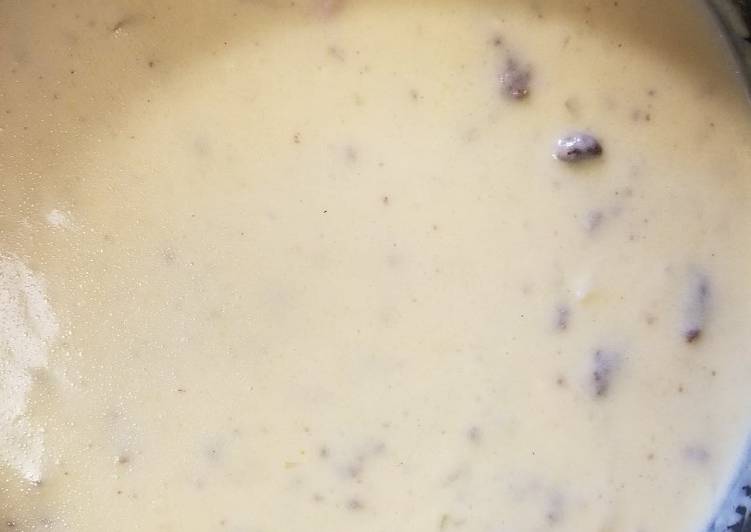
Hello everybody, it is Louise, welcome to my recipe page. Today, I will show you a way to prepare a distinctive dish, sourdough croissants. One of my favorites. This time, I will make it a little bit unique. This is gonna smell and look delicious.
Sourdough Croissants is one of the most favored of recent trending foods in the world. It is easy, it is quick, it tastes yummy. It is appreciated by millions daily. Sourdough Croissants is something that I have loved my entire life. They’re fine and they look wonderful.
These Sourdough Croissants are the best croissants ever! To have fresh Sourdough Croissants The difference between Classic Croissants and Sourdough Croissants is the use of the natural. Then perfect your lamination, using puff pastry and Yeasted croissants before moving on to sourdough croissants.
To begin with this particular recipe, we must first prepare a few ingredients. You can have sourdough croissants using 8 ingredients and 10 steps. Here is how you cook it.
The ingredients needed to make Sourdough Croissants:
- Get 90 g Sourdough starter
- Make ready 340 ml Milk
- Take 5 g Instant Yeast
- Make ready 575 g All-purpose Flour
- Get 40 g sugar
- Prepare 9 g salt
- Make ready 40 g softened butter
- Take 350 g refrigerated butter
These sourdough croissants are based loosely on a recipe by Shipton Mill and an adaptation of my recipe for croissants made with commercial yeast. This sourdough croissant recipe is fun to make, and yields delicate flakey layers with a slight sourdough taste. You won't want to stop making and eating them! Flaky, buttery and a dozen of these cost about the same as one bakery Baking croissants seems like such a huge, fussy deal.
Steps to make Sourdough Croissants:
- On the morning of day 1 (for this is a 2-day recipe) mix together all of the ingredients (except the refrigerated butter). Knead into a dough. Wrap in clingfilm and refrigerate until the afternoon.
- In the afternoon, when you are ready to start the lamination, get the butter out of the fridge, sandwich it between two sheets of clingfilm, and then beat it flat with a rolling pin. It should end up about 5mm thick, and it should be a rectangular slab.
- Take the dough out of the fridge and roll it flat so that it is just slightly larger than twice the size of the butter slab. place the butter on one half of the dough, and fold the dough over so that it completely encloses the butter. pinch the edges to seal. Cover with clingfilm and return to the fridge for 15 mins.
- Now the lamination begins. remove dough from fridge and roll it as flat as you dare. try to make it long and thin. Then do a set of book folds. ie. fold one third into the middle then fold the other third on top of it. It should now be 1/3 of the size and 3 times as thick. Cover with clingfilm and return to the fridge for 15 mins.
- Repeat the previous step 2 more times (for a total of 3 folds). Then wrap in clingfilm and leave the dough in the fridge overnight.
- The morning of day 2, take the dough out of the fridge and roll it flat. This may take a while. The goal is to make the dough about 5mm thick (and rectangular). But your dough may be easier or harder to roll (just because) so don't worry if you don't quite get there.
- Cut the dough into long rectangles, as shown. Depending on the ratio of the rectangle you made in the previous step, your croissants may be short and fat or long and thin. (Long, thin rectangles make short fat croissants)
- Make a cut in the shortest side of the triangle, and roll into a croissant shape. If your dough allows it, you can stretch the dough a little to help create the shape you want (if you've not done this before, a video is really helpful - Google how to shape croissants) This pastry is quite versatile - we also made cinnamon buns and turnovers from the end scraps - so you can be a bit creative with the shape of your pastries.
- Cover and prove at room temperature. Ideally, the croissants should double in size. We were a bit impatient and just baked them after 2 hours. This seemed to work. The resulting croissants were quite dense (which by happy coincidence is how I like them). Waiting for them to expand more might produce less dense (more traditional) croissants.
- Brush with beaten egg and bake at 230C (450F) for 5 minutes, then reduce to 180C (350F) and bake for 15 minutes. Add a dish of water to the oven to increase humidity. We tried to bake the first batch on a pizza stone, but a decent amount of butter leaked out during the baking, which dripped off the edge of the stone and caught fire on the bottom of the oven. So possibly use a baking tray.
I always thought I'd take one whole day, prop. I must admit I am a little obsessed with Sourdough croissants made in the Thermomix. Once you have made them you will never want to go back. In my last croissant post(see here), I said I am practicing once or twice every week to perfect my lamination skill. It's been more than a month, and my croissant fever is getting hotter – sadly, what's.
So that’s going to wrap this up for this special food sourdough croissants recipe. Thank you very much for reading. I am confident you will make this at home. There is gonna be interesting food at home recipes coming up. Remember to save this page on your browser, and share it to your family, colleague and friends. Thank you for reading. Go on get cooking!


